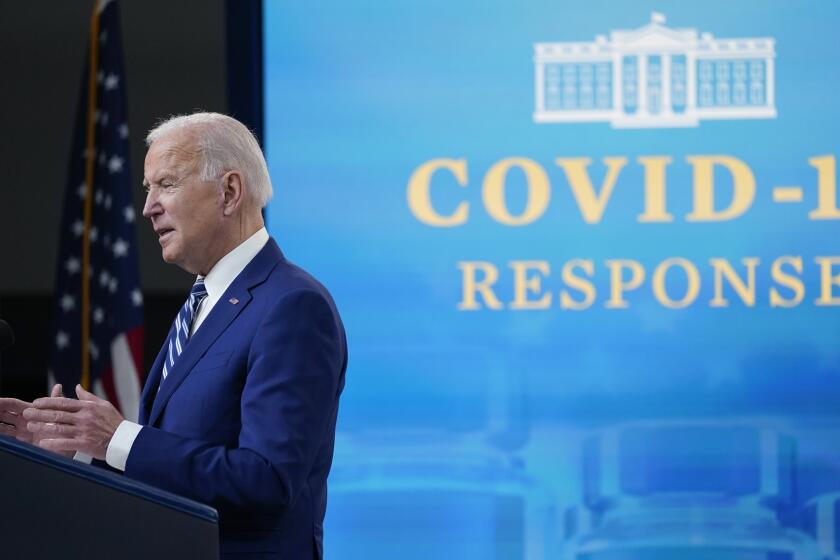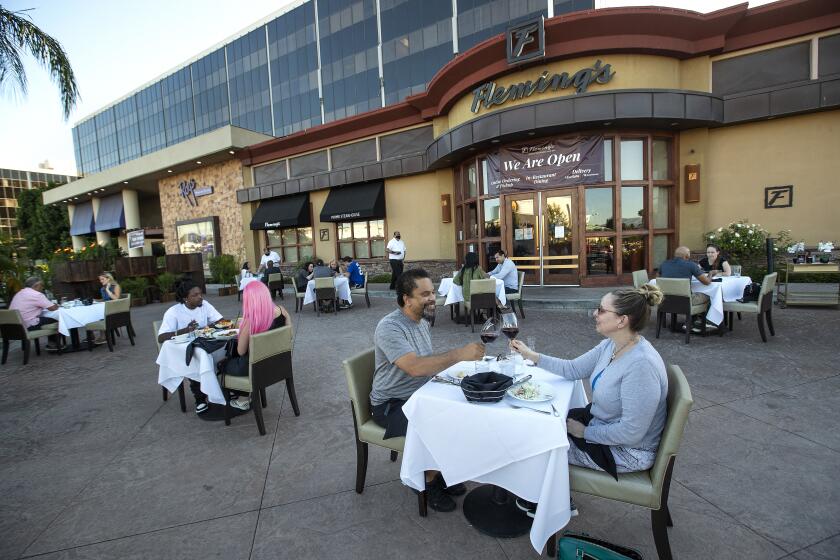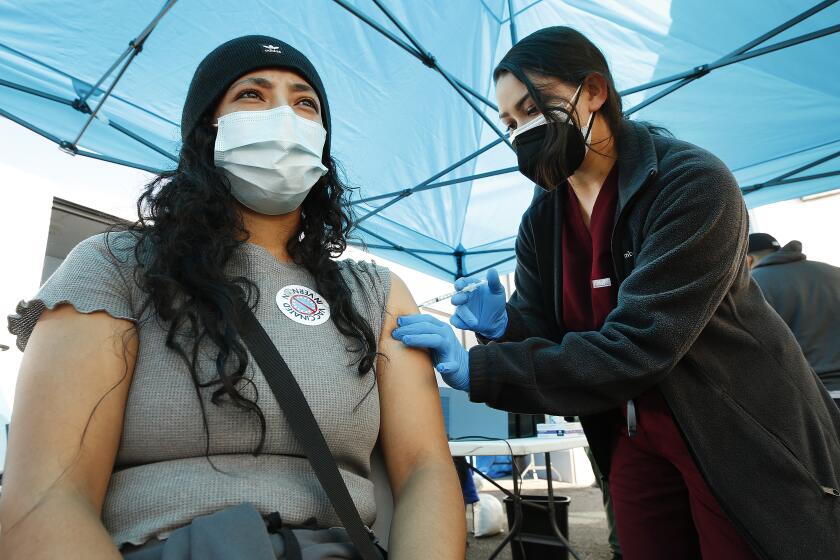Some say ‘the pandemic is over’ in California as crowds return. Experts are worried
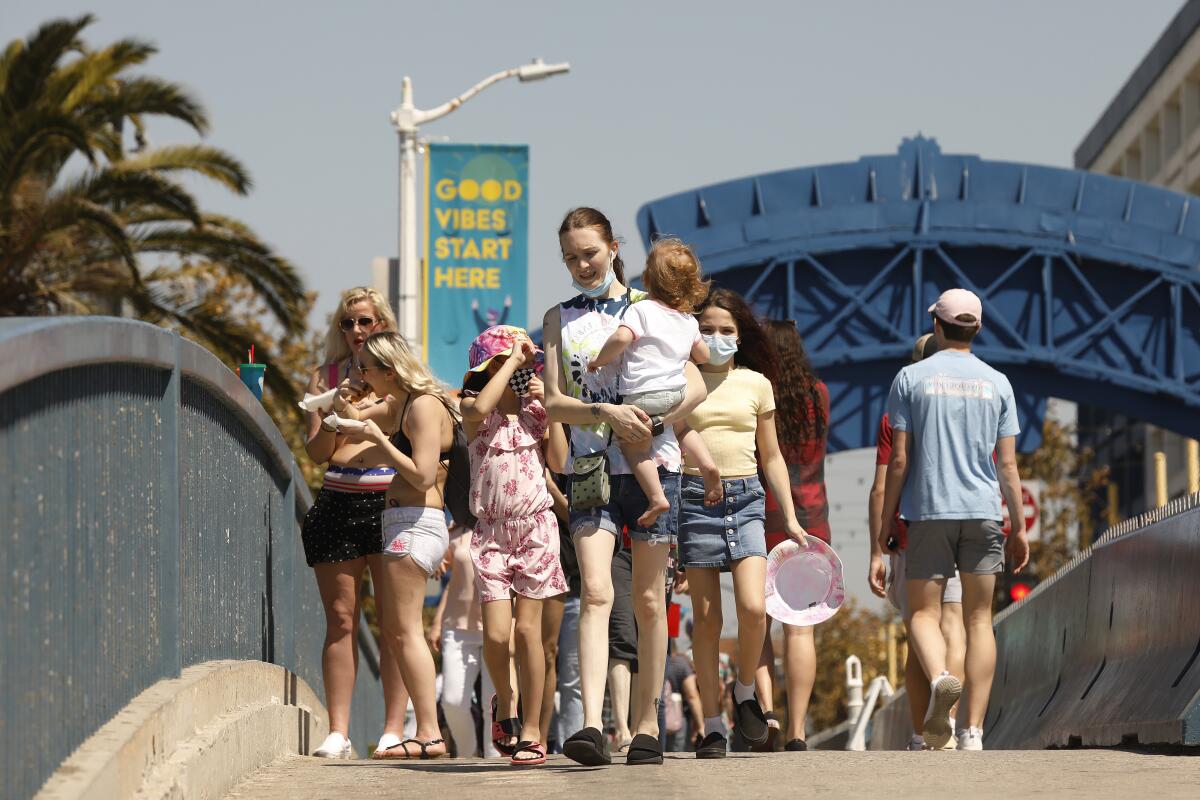
- Share via
On a bright balmy morning in Santa Monica, Angelica Far lounged on a green deck chair, sipping a frozen coffee and taking in the sun.
The 43-year-old had just arrived from Chicago with her two kids and their puppy, a beagle named Bella.
When asked what brought them to Southern California, Far had three words: “Mental health break.”
And she was not alone. With coronavirus cases on the decline, vaccinations increasing and temperatures warming, Santa Monica and other towns have been bustling in recent days with a bevy of tourists and travelers, skateboarders, beachgoers and brunchers.
After a year of business closures and travel restrictions that devastated the tourist economy, merchants and visitors say activities are starting to pick up.
“I do feel like the pandemic is over,” said Kemuel Kendrick, 19, who was shopping in the Santa Monica Promenade with three friends from Charleston, S.C. “Obviously, we all have masks on, but otherwise, I don’t really have that fear anymore.”
Biden accelerates COVID vaccinations, while a top health official says she has a sense of ‘impending doom’ amid a new wave of infections and deaths.
But one person’s carefree holiday is another’s sleepless night.
And public health officials are growing increasingly worried that the next week or so — spring break combined with Passover and Easter Sunday — could unwind California’s hard-won gains against the coronavirus. The confluence of events could spark increased travel, social gatherings and celebrations — all of which could, without precautions, heighten the risk of coronavirus transmission.
“What we’re seeing now is more travel than we saw throughout the pandemic, including the Christmas and New Year’s holidays,” Dr. Rochelle Walensky, director of the Centers for Disease Control and Prevention, said during a briefing Monday. “I think people have taken advantage of what they perceive as a relative paucity of cases, relative lull in where we were, to take advantage of their time of spring break and of holiday travel. And what I would just say is we’ve seen surges after every single holiday — July 4, Labor Day, Christmas — and we’re seeing the uptick of that right now.”
So far, the state has not seen the same kind of spike in coronavirus cases that has sparked alarm in other parts of the country.
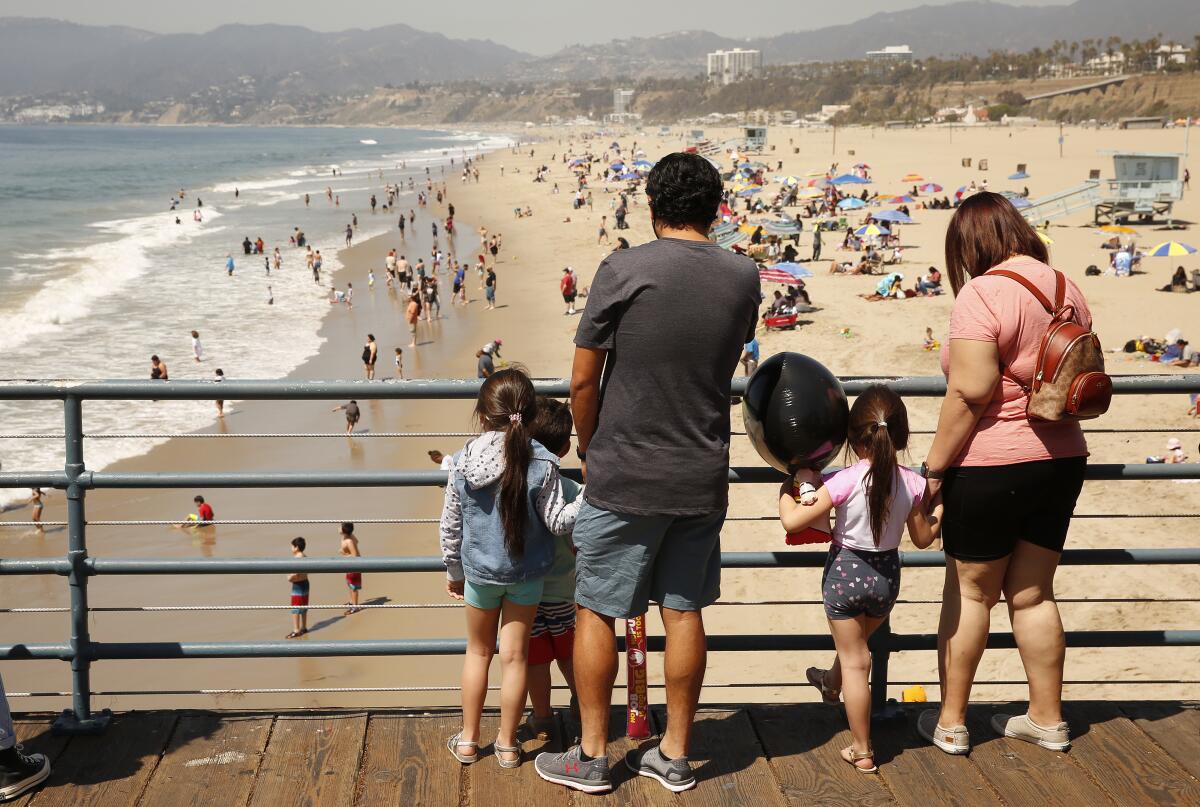
But California has seemingly been an early outlier in the past, only to be hit later.
Health experts say the next few weeks will be crucial for California to keep COVID-19 infection rates down and allow many more people get vaccinated.
“I know it’s been very lonely for a lot of folks. It’s been hard,” said Dr. David Hayes-Bautista, a distinguished professor of medicine at the David Geffen School of Medicine at UCLA. “So there’s a real temptation to bust loose just for one night because ‘it doesn’t matter.’ Well, it does matter.”
In many ways, this time of year seems tailor-made to test the resolve of pandemic-weary Californians.
It’s spring break season, and many people — particularly younger adults — may be looking to forget about their upended lives for a while. Holidays like Easter and Passover are normally cause to celebrate with family, friends and fellows in faith.
Calls for continued vigilance may also be falling on deaf ears in a state like California, where COVID-19 appears to be in retreat. Cases, hospitalizations and deaths are on the decline, and vaccinations are ramping up.
Things have improved to the point that some areas — including Los Angeles and Orange counties — are poised to further unlock their economies, opening up new opportunities for residents to socialize and let off steam.
Already, businesses are preparing for a boom.
David Hardie, manager of the Water Grill restaurant on Santa Monica’s Ocean Avenue, said the number of diners has steadily increased over the last two weeks. On Sunday, the restaurant brought in $19,000 in lunch sales, he said. They would have been lucky to break $6,000 during the darkest days of the autumn and winter surge.
“Things are definitely coming back,” Hardie said as servers ferried dishes to diners, including a handful who were sitting at tables inside. “And we’re very excited.”
All that rosy news, however, doesn’t eliminate the agonizing thorn in the state’s collective side.
“This is a deadly and serious virus. It’s not taking spring break away, it’s not taking the summer off. We have to defeat it,” Gov. Gavin Newsom said last week.
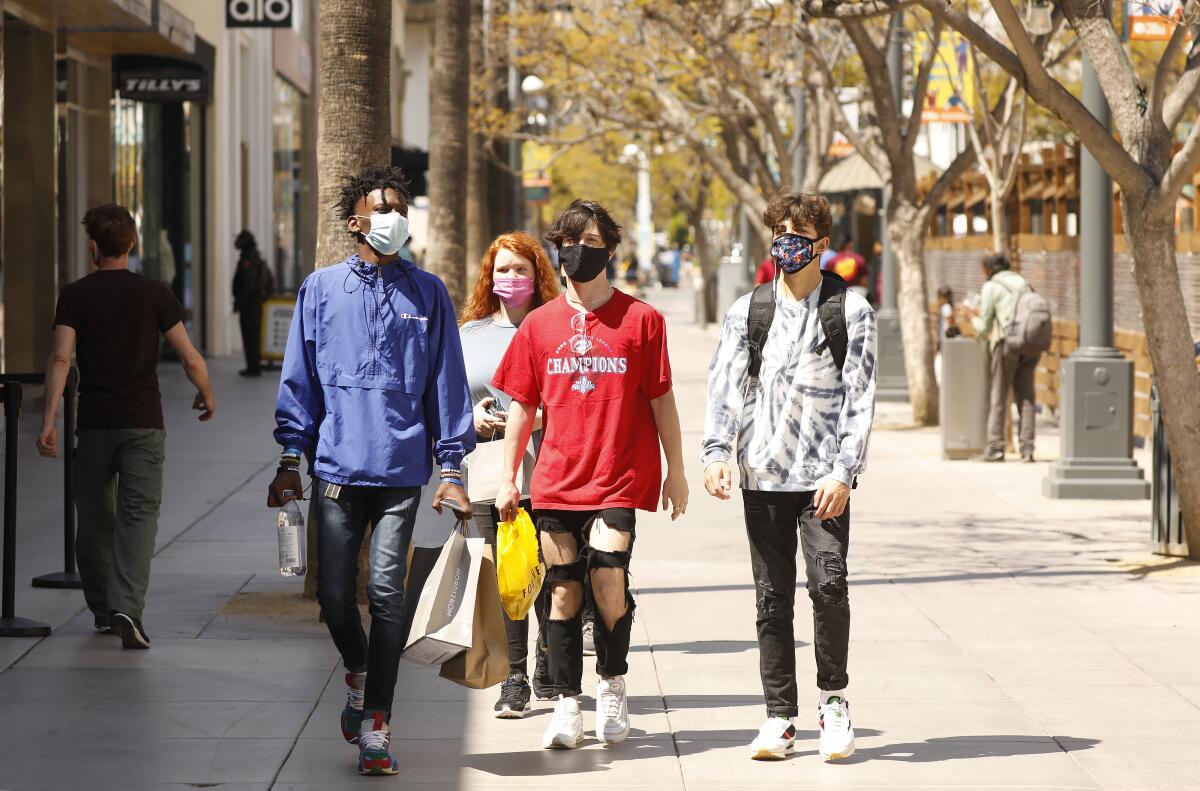
As of Sunday, the seven-day national average for newly reported coronavirus cases was 61,632, up 13% from the week prior, according to data from the U.S. Centers for Disease Control and Prevention.
California, however, is trending in the opposite direction — at least for now. Over the last seven days, the state has reported an average of 2,546 new coronavirus cases per day, a 24% decrease from two weeks ago, according to data compiled by The Times.
CDC data show that the state’s latest seven-day case rate per 100,000 people, 42.8, is the second-lowest among all states and well below the national rate of 130.
The comparable rate over the same period was 450.4 in New York City, 237.3 in the rest of New York state, 162.3 in Florida and 92.8 in Texas.
We traveled around the L.A. region to ask people whether or not they would take the vaccine, and if not, why. Then we posed their questions to two experts. Here’s what they said.
It’s not exactly clear why California’s numbers are so comparatively good at this point. However, some health officials point to the fact that other states have moved to rescind mask mandates and much more broadly relax pandemic-related business restrictions.
“I think the reason we’re seeing this plateauing and a bit of a little increase that we hope doesn’t turn into a surge is because we are really doing things prematurely right now with regard to opening up,” Dr. Anthony Fauci, the nation’s leading infectious disease expert, said during a briefing Monday.
Others have wondered whether California may be benefiting from the fact that so many residents have some degree of protection against COVID-19 — either because they were previously infected or because they’ve been at least partially vaccinated.
“At the moment, we don’t know what’s driving our current good experience,” Paula Cannon, a professor of molecular microbiology and immunology at the Keck School of Medicine at USC, said in an interview Monday. “But whatever it is, I hope we keep doing it.”
But health officials are quick to point out that California doesn’t exist in a vacuum.
“This past year indicates that often the East Coast experiences increases in cases before the West Coast and that, typically, L.A. County is a few weeks behind New York,” Los Angeles County Public Health Director Barbara Ferrer said last week.
Passover began Saturday, and Easter is in one week, prompting health officials to urge the public to take precautions when gathering.
That’s why this time of year is raising so many warning flags for health officials and experts, who say that travel — whether for holidays, spring break or just for the heck of it — only heightens the risk of spreading and contracting the coronavirus.
“This is our concern. People have been locked up, cooped up for a year,” Hayes-Bautista said. “There’s going to be a real temptation for these young adults to go out and meet some friends.”
On Sunday, 55,169 passengers passed through security at Los Angeles International Airport. That’s the highest single-day figure since the pandemic began, a spokesperson said, but still fewer than half as many people as came through the airport on the same date in 2019.
“We’ve not yet got quite enough people vaccinated that we have full resilience to accommodate any complete loosening up of behavior,” Cannon said. “We’re almost there, but we can be derailed if a lot of unvaccinated people travel without precautions.”
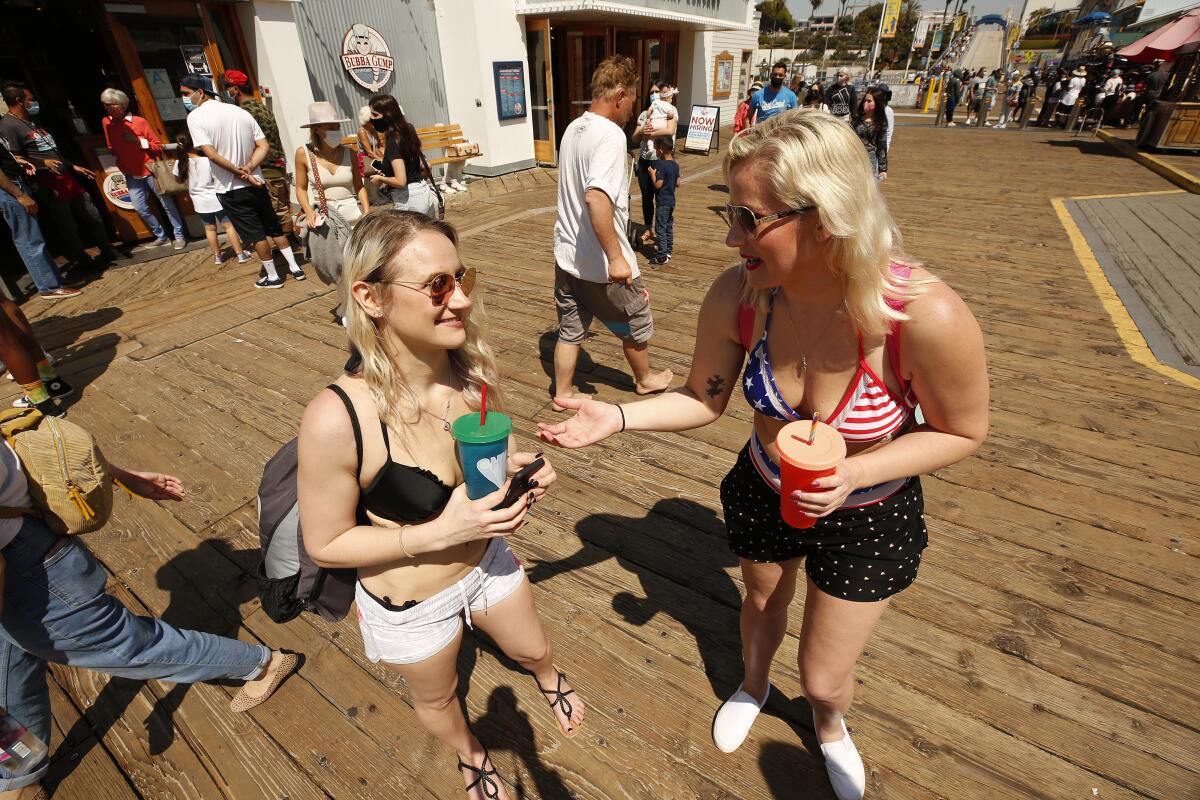
Stephanie French, 32, and Mariah Sand, 39, flew into L.A. from Seattle early Monday to enjoy the beach. They planned to take the red-eye back that night.
“We just wanted some sun,” French said.
Neither she nor Sands wore face masks — French said she lost hers on the beach — and neither was sure if they would be taking the COVID-19 vaccine. They also said they’re not worried about a new surge or about new variants of the virus.
Eric Rush, who works a T-shirt stand on the boardwalk, was happy to see so many people. During the last year, the stand was shuttered for months, and in December, he caught COVID-19.
“It feels like summer,” he said, motioning to the beach just behind him, where scores of people splashed in the surf. “I just hope everything can get back to normal. I mean, it’s L.A., after all.”
California is days away from dramatically expanding who is eligible to receive a COVID-19 vaccine. But will there be enough doses to go around?
Because of the lagging nature of the coronavirus, it will take weeks to determine whether a springtime surge will strike California.
Even if one does, however, some experts said they’re hopeful it will be significantly more mild than the devastating wave that walloped the state over the fall and winter.
“If we do get another surge, what we’d likely get is a surge of infection without the devastating consequences, because the people who are most vulnerable are over 65, people with underlying health conditions, front-line workers, and so many of those have been vaccinated,” Cannon said.
Joe Dubois, 27, was among the crowd watching skateboarders in the skate park at Venice Beach on Monday.
Dubois, who lives in South Pasadena and works in software engineering, said he has been encouraged to see positivity rates improving locally.
“Things are definitely getting looser,” he said, noting that he is getting more comfortable spending time with friends outside, and even hosting the occasional person inside.
Still, he is cautious and careful when it comes to following mask and physical distancing guidelines.
“My behavior hasn’t changed, but my mind-set has,” he said.
More to Read
Sign up for Essential California
The most important California stories and recommendations in your inbox every morning.
You may occasionally receive promotional content from the Los Angeles Times.
